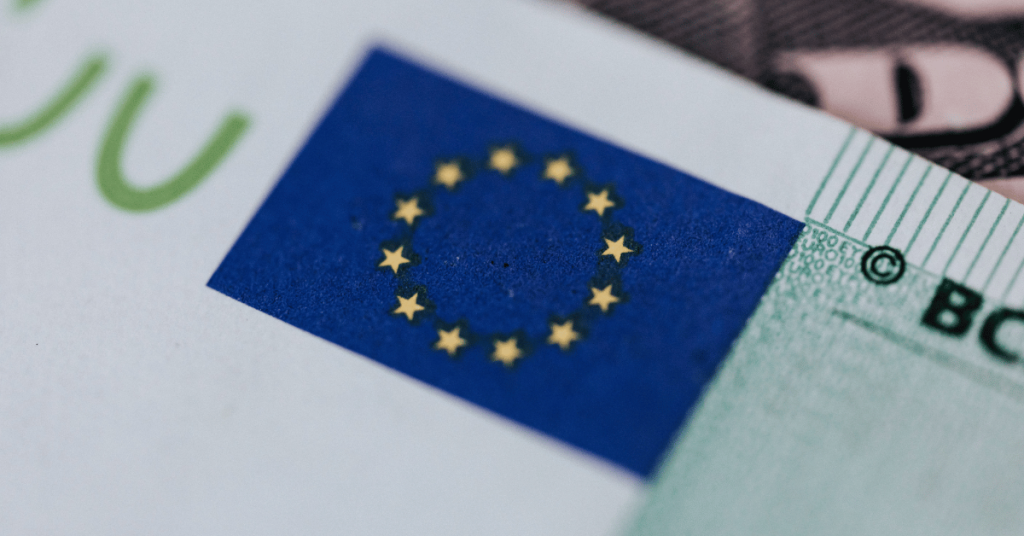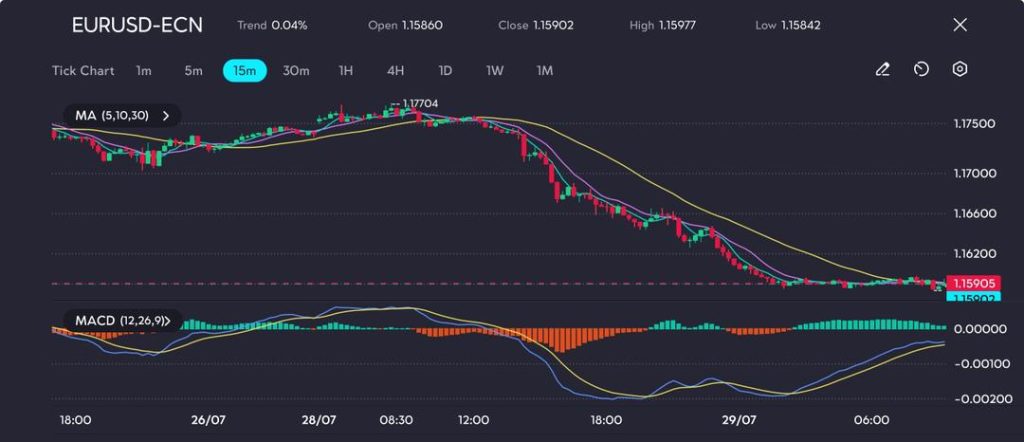
Trade tensions and political uncertainty have weighed on the euro this week, while the US dollar gained strength on safe-haven demand and renewed global engagement. With central bank guidance and policy risks in focus, EUR/USD remains under pressure.
Euro under renewed pressure
The euro struggled to recover this week following Monday’s sharp 1.3% decline – its steepest one-day drop in over two months.
EUR/USD was last seen trading at $1.1594, rising only 0.07% as markets absorbed the broader implications of the newly ratified US-EU trade agreement.
The deal triggered political backlash across Europe. French officials condemned it as a “dark day” for the continent, while German Chancellor Friedrich Merz warned that the 15% base tariff on EU exports could cause significant harm to Germany’s export-driven economy.
Falling European bond yields added to the euro’s weakness, helping the US dollar strengthen further. The Dollar Index (USDX) gained 1% overnight to reach 98.67.
This strength also dragged the British pound to a two-month low of $1.3349 and pushed USD/JPY higher to 148.49.
Outside Europe, dollar strength was reinforced by growing signs of renewed US diplomatic engagement.
Macquarie strategist Thierry Wizman suggested the dollar’s rise reflects more than trade – it signals a wider re-engagement strategy.
President Trump also warned that countries without standalone deals may face tariffs of 15–20%, intensifying global trade uncertainty.
Meanwhile, US-China talks resumed in Stockholm, extending their trade truce by another three months.
Traders now await interest rate decisions from both the Federal Reserve and the Bank of Japan. While no changes are expected, forward guidance could shape market direction into the next quarter.
Technical analysis
EUR/USD remains in a clear downtrend after peaking near 1.1770, forming a series of lower highs and lower lows over recent sessions.
Both the 5- and 10-period moving averages are sloping downward, confirming continued bearish momentum.
Price is currently trading just beneath these short-term averages, highlighting sustained selling pressure.

Picture: EUR/USD breaks below key support after a relentless downtrend from 1.1770, as seen on the VT Markets app.
Although the MACD remains in negative territory, the histogram bars are beginning to contract slightly – indicating a possible, albeit limited, slowdown in downward momentum.
A decisive move below 1.1580 could open the door to further losses toward the 1.1530 support area.
On the upside, a break above 1.1620 would be needed to challenge the current descending trendline and potentially shift sentiment.
Bearish outlook unless key resistance breaks
Unless EUR/USD can decisively reclaim the 1.1620 level, the pair remains vulnerable to further downside pressure, with 1.1550 seen as the next key support.
A brief consolidation may occur near this level, but any sustained recovery would likely require a clear shift in market sentiment or fresh macroeconomic catalysts.
Traders remain cautious as geopolitical tensions and trade uncertainties weigh on confidence. The euro continues to struggle amid concerns over export tariffs and the broader impact of the US-EU trade deal, which many analysts believe could undermine European competitiveness in the months ahead.
Looking ahead, forward guidance from the Federal Reserve and the European Central Bank will be closely watched.
Any signals regarding inflation outlook, interest rate timelines, or monetary policy adjustments could influence near-term price action.
As Q3 progresses, these policy cues will be crucial in determining whether EUR/USD can stabilise – or slip further into bearish territory.
Click here to open account and start trading.





